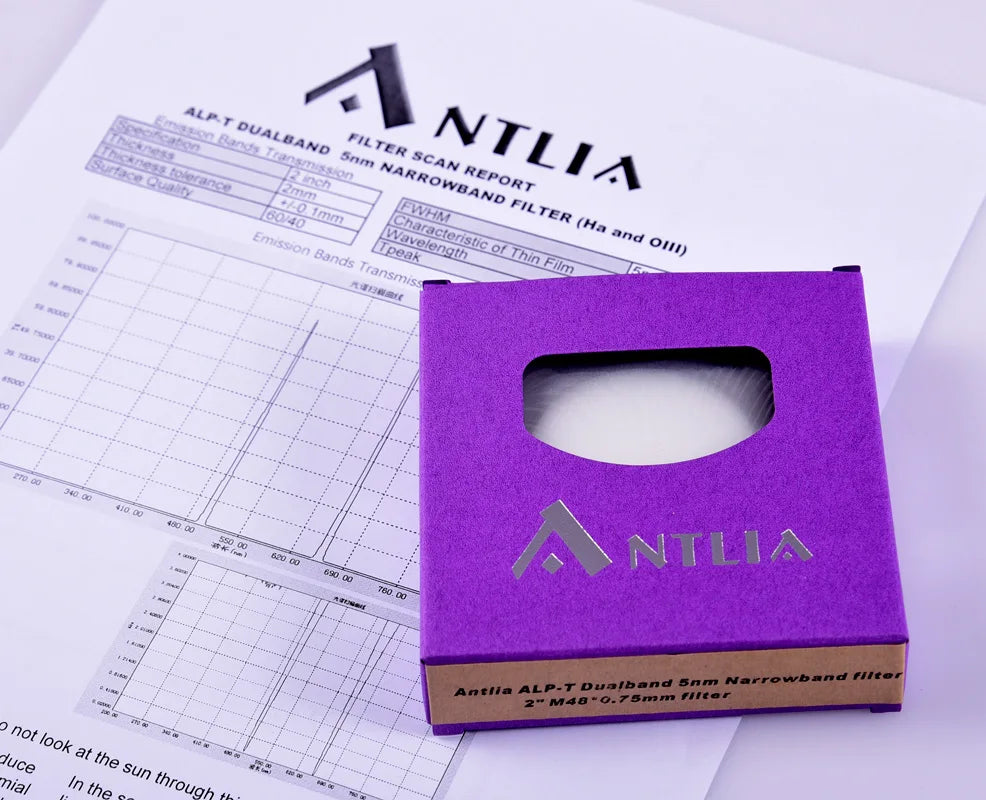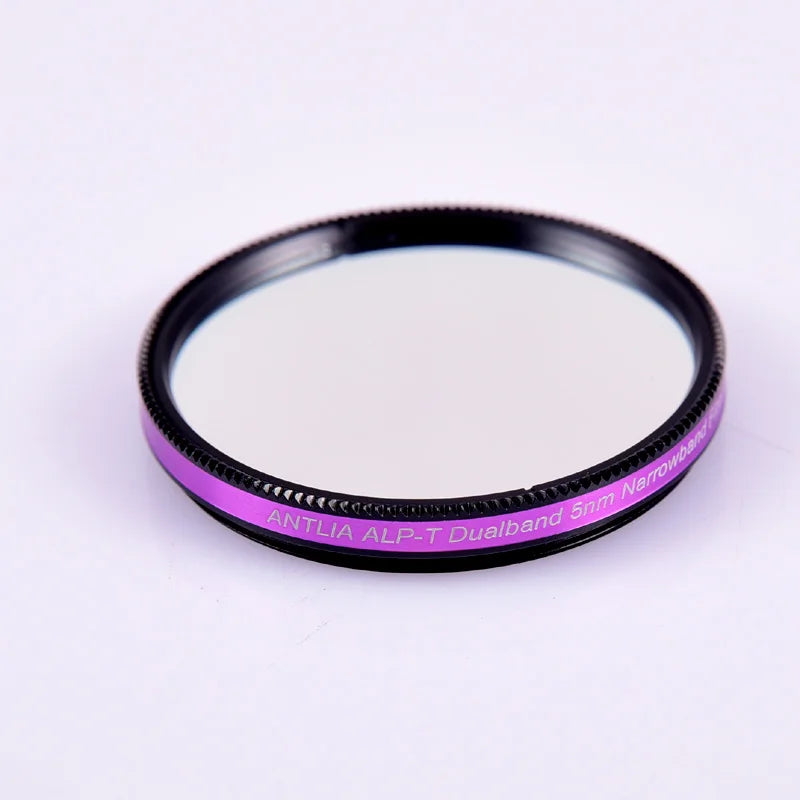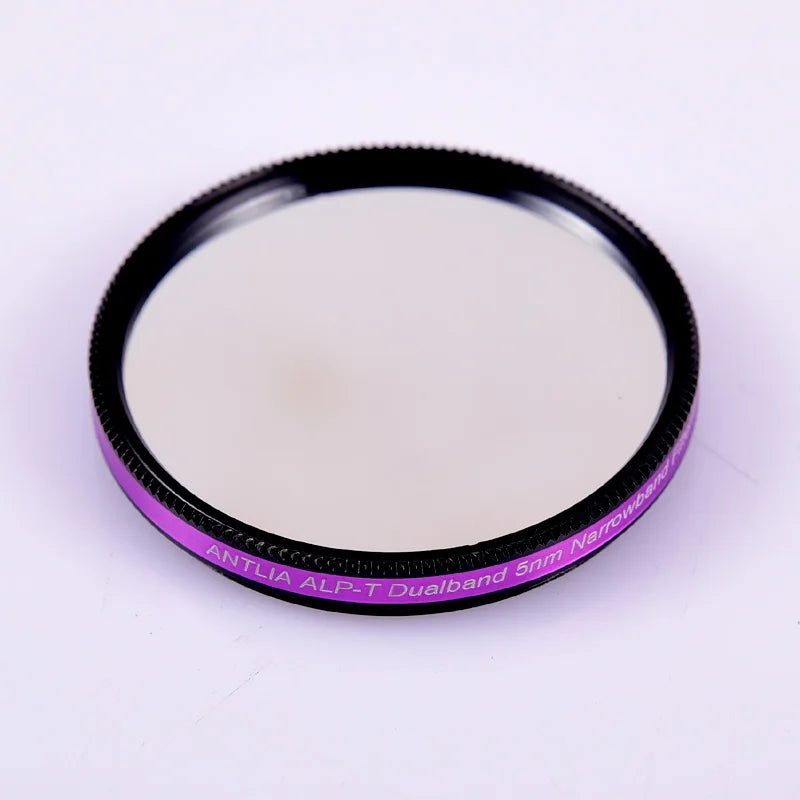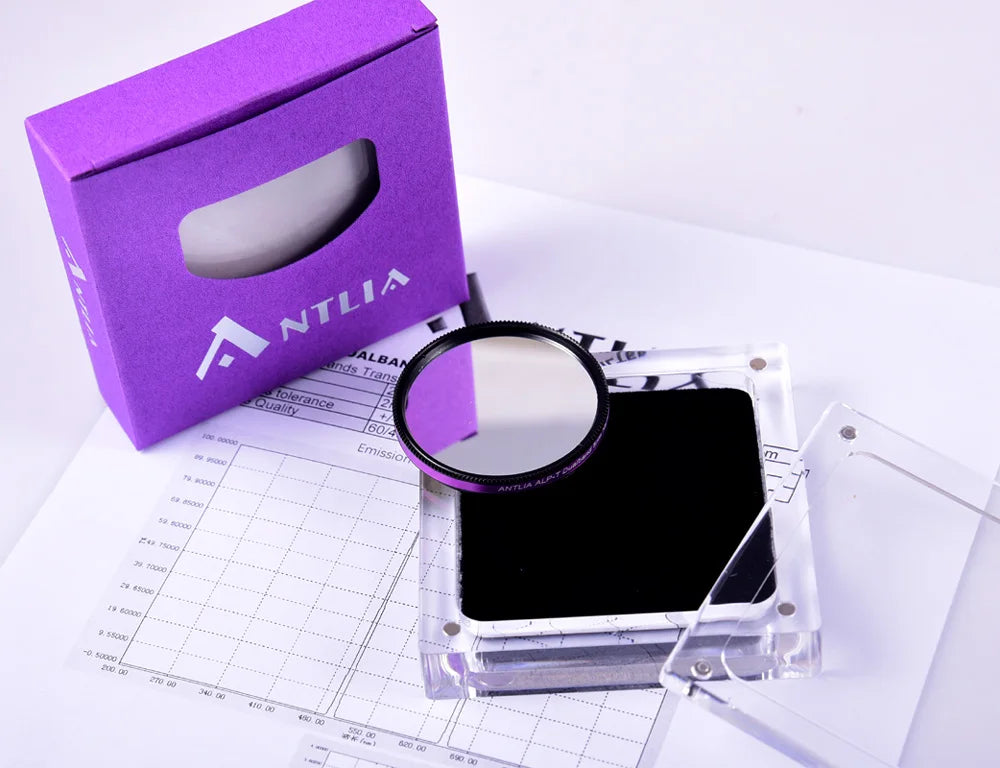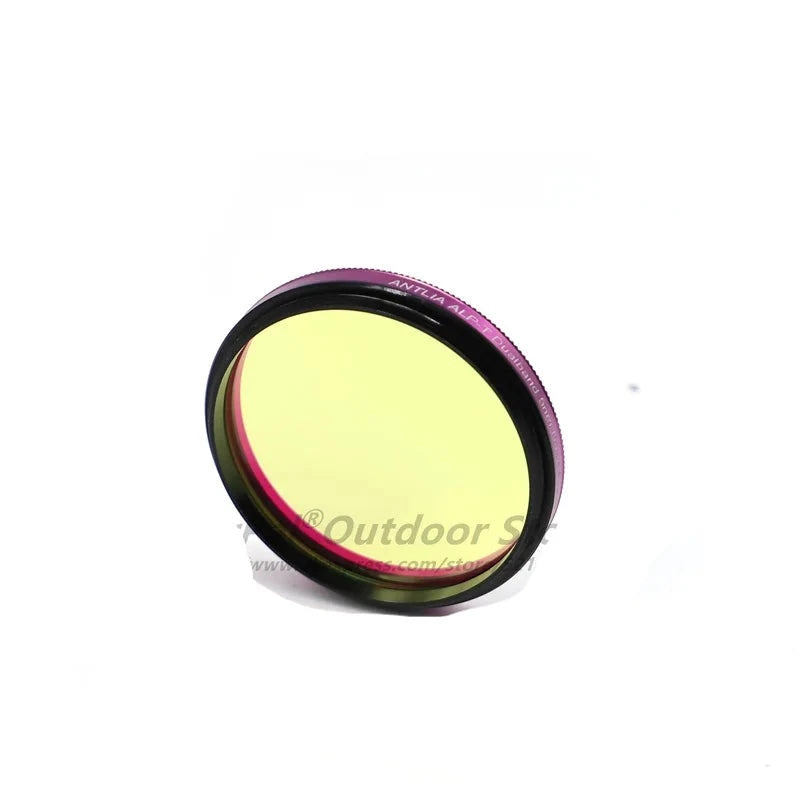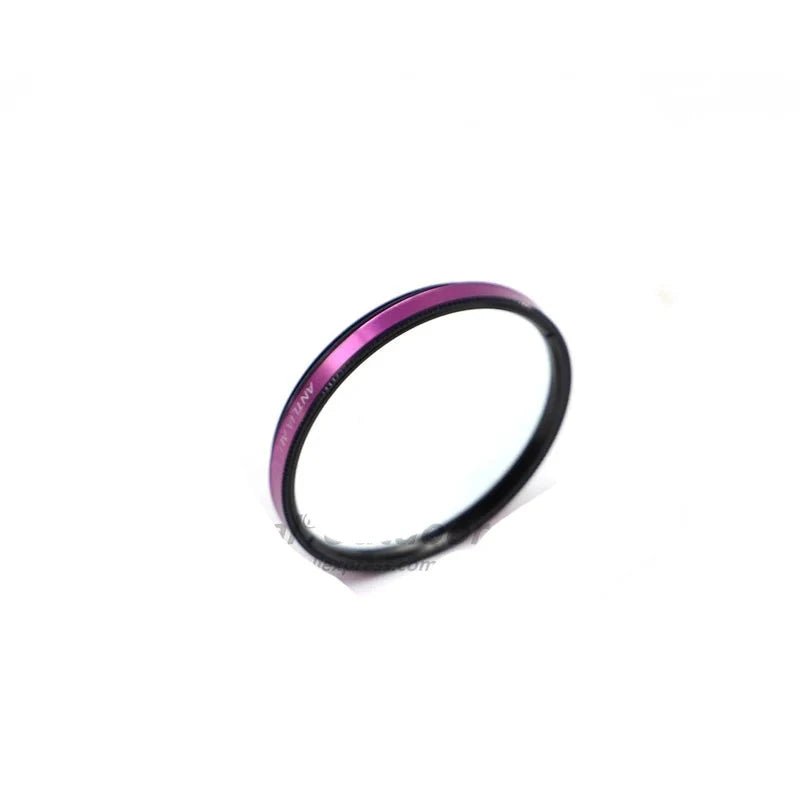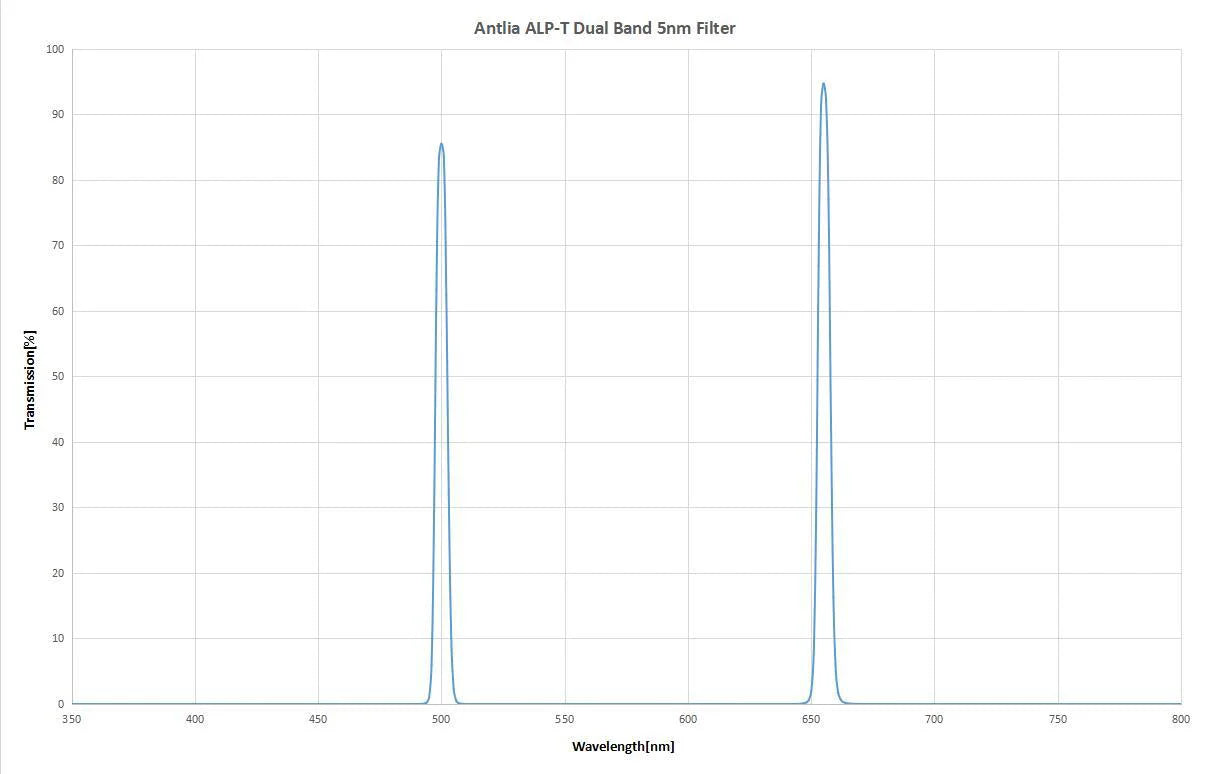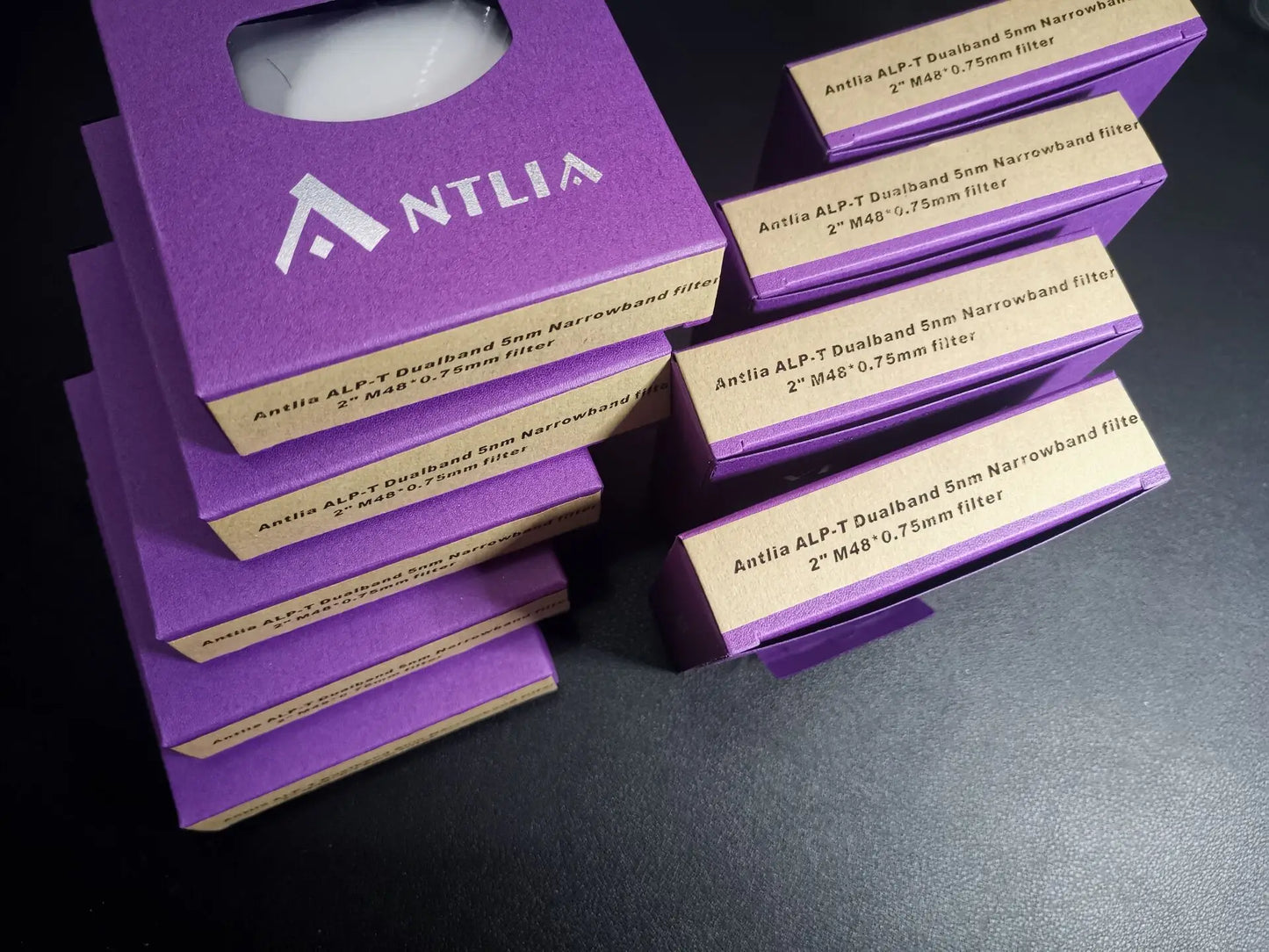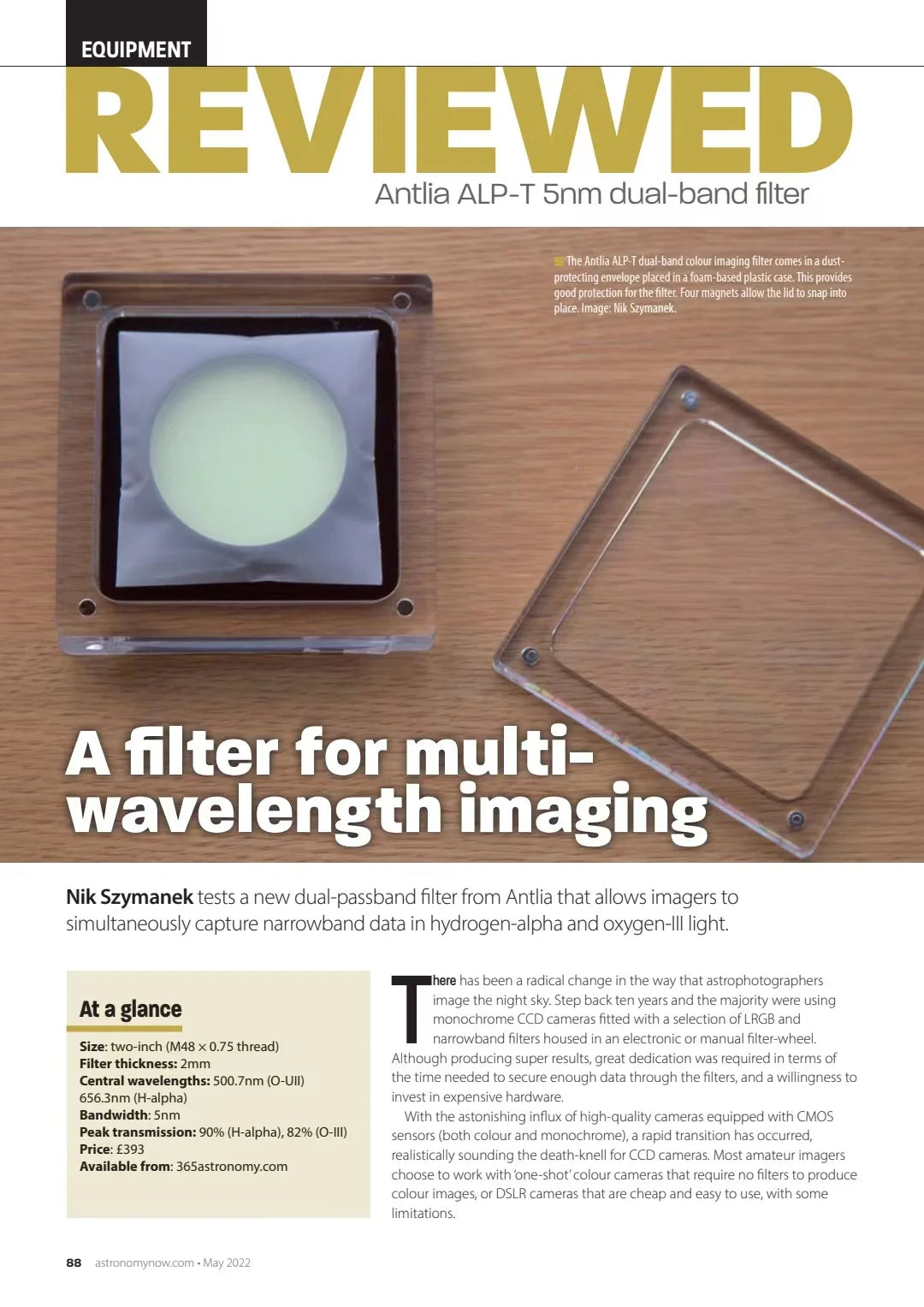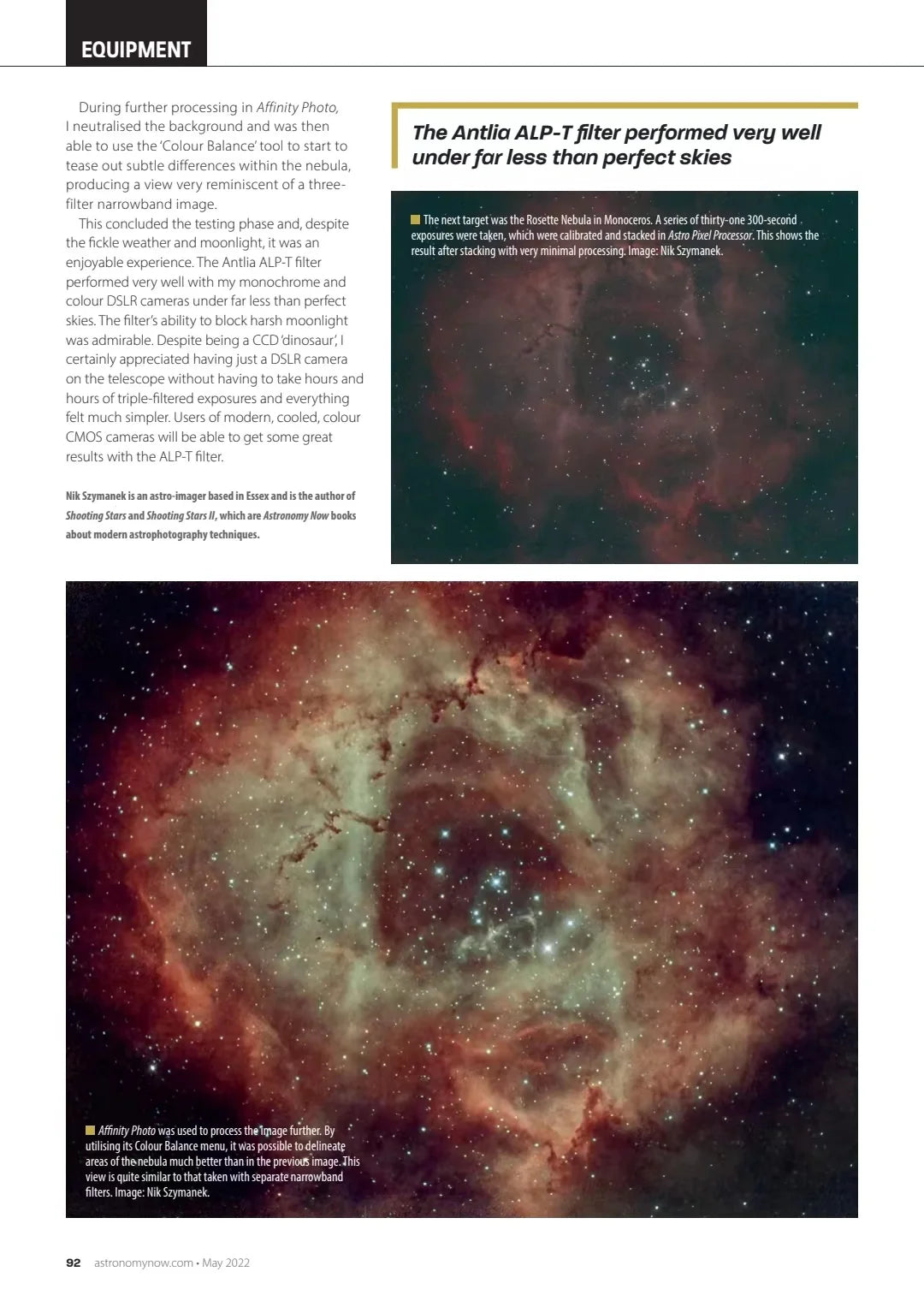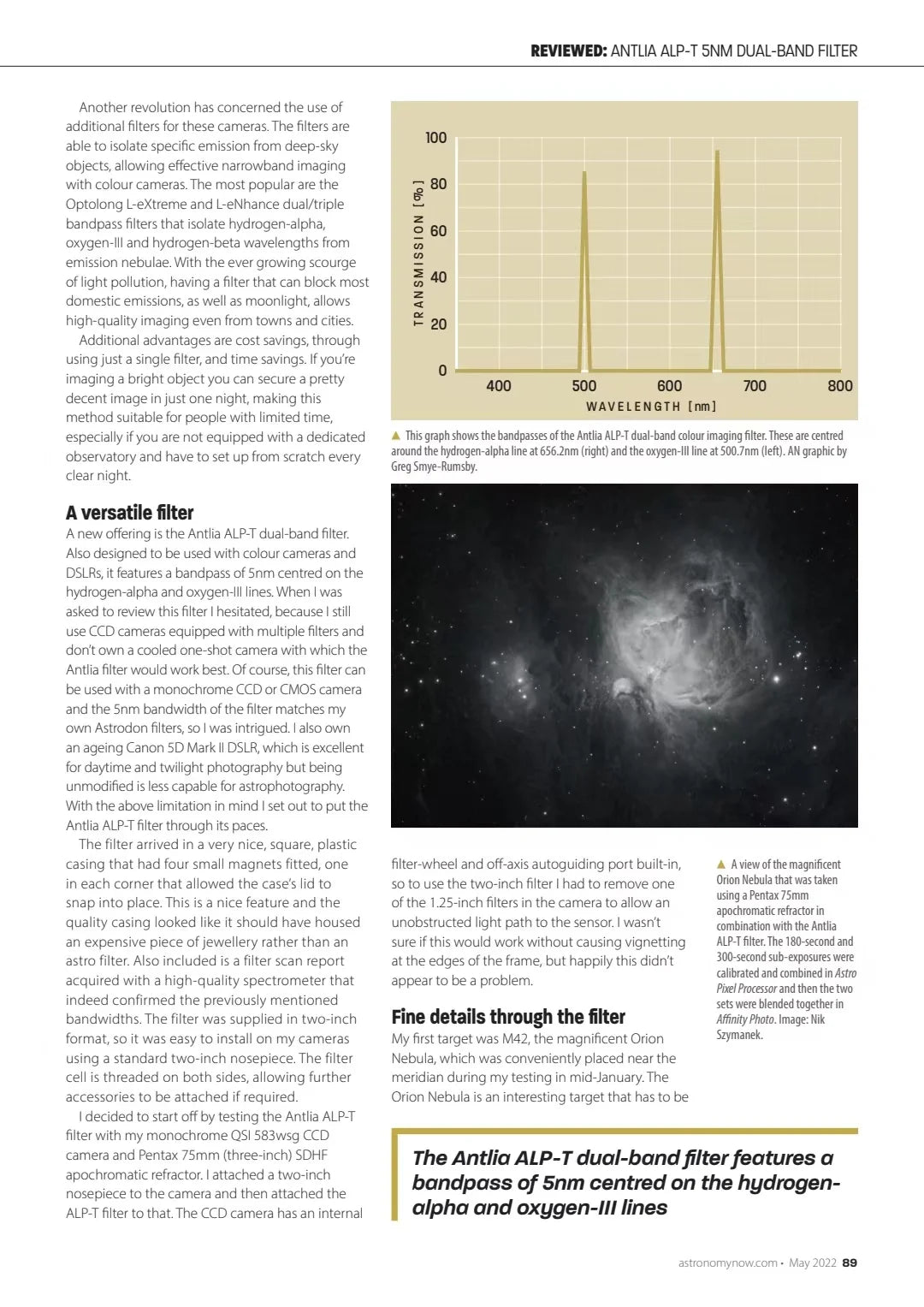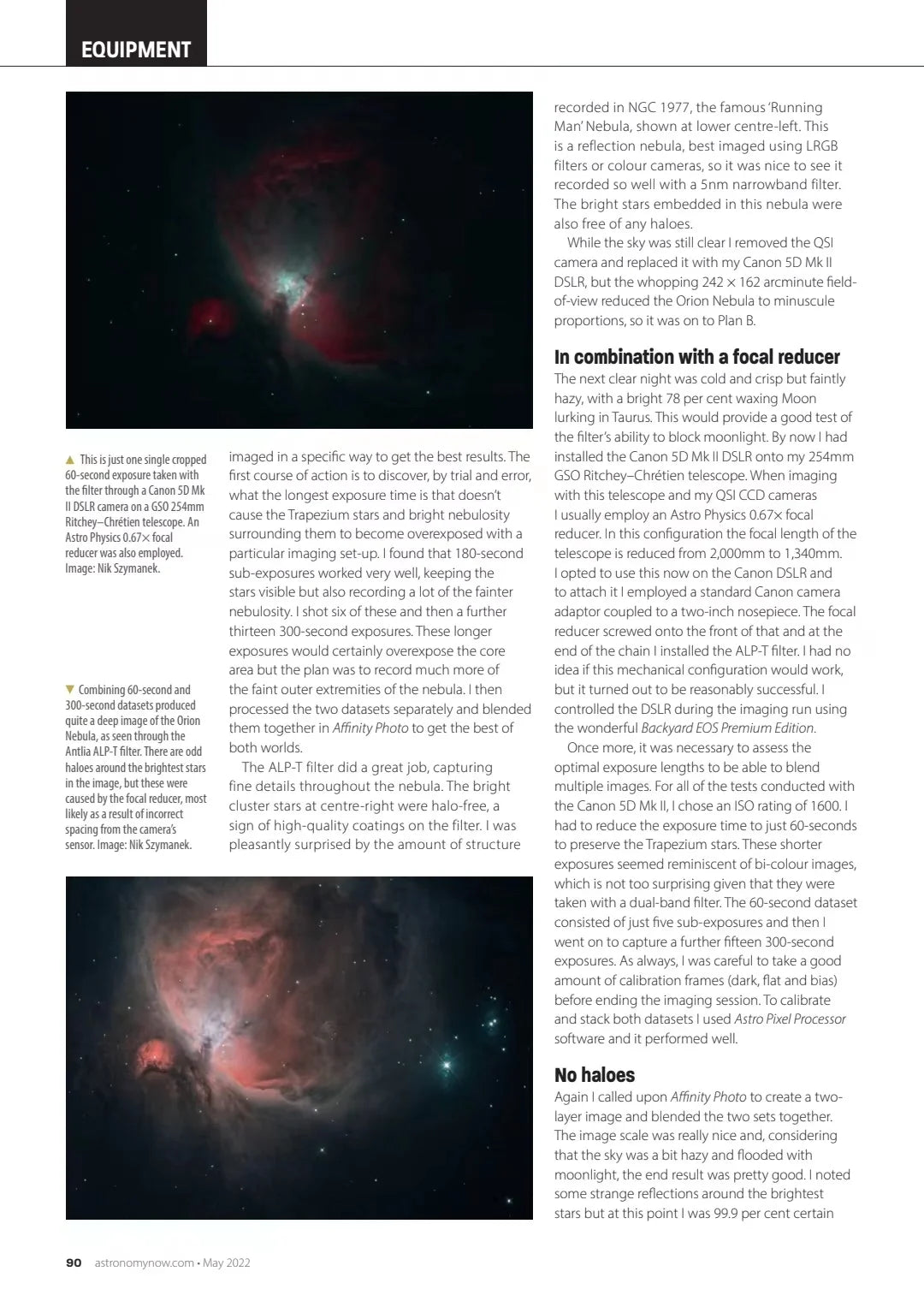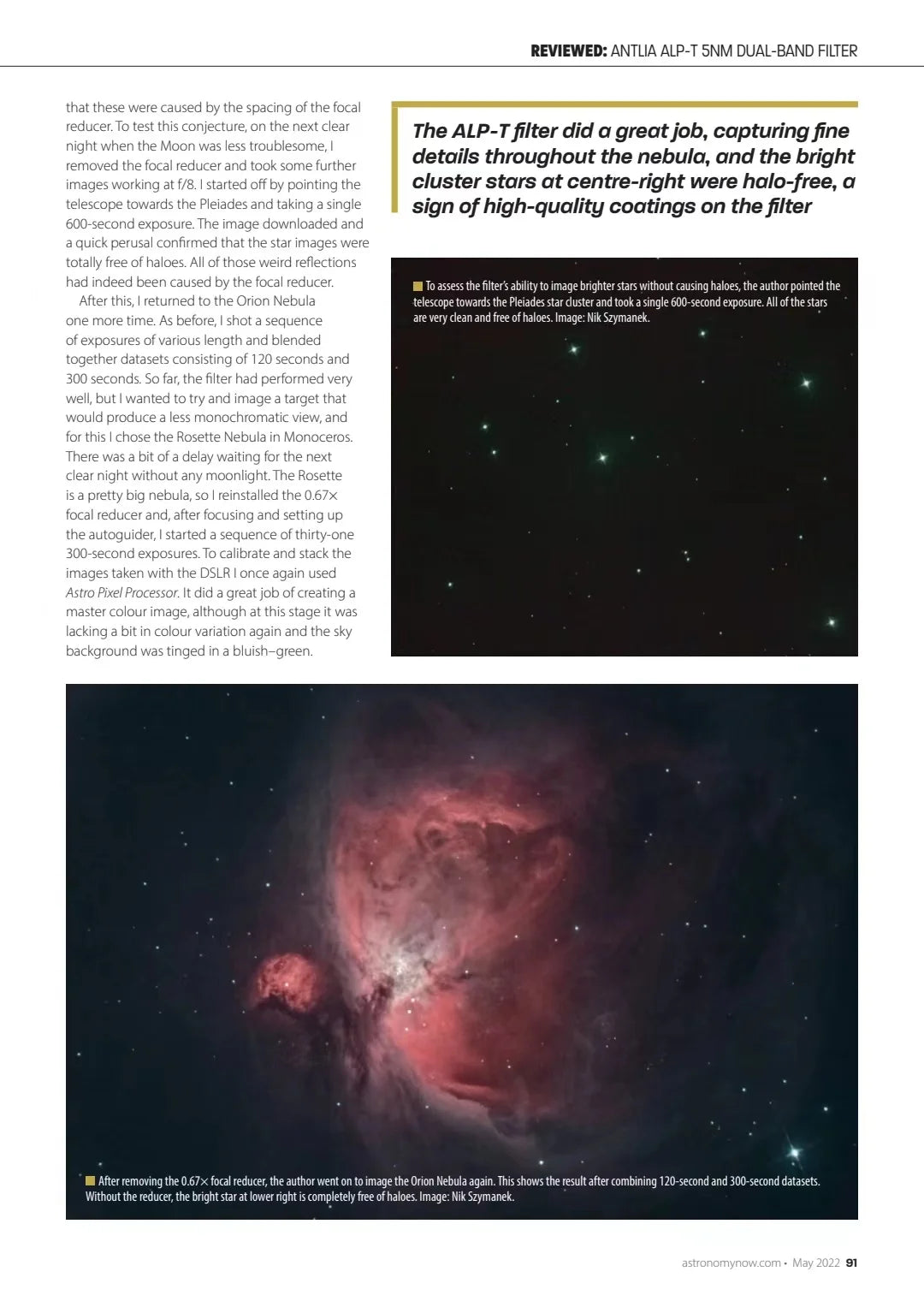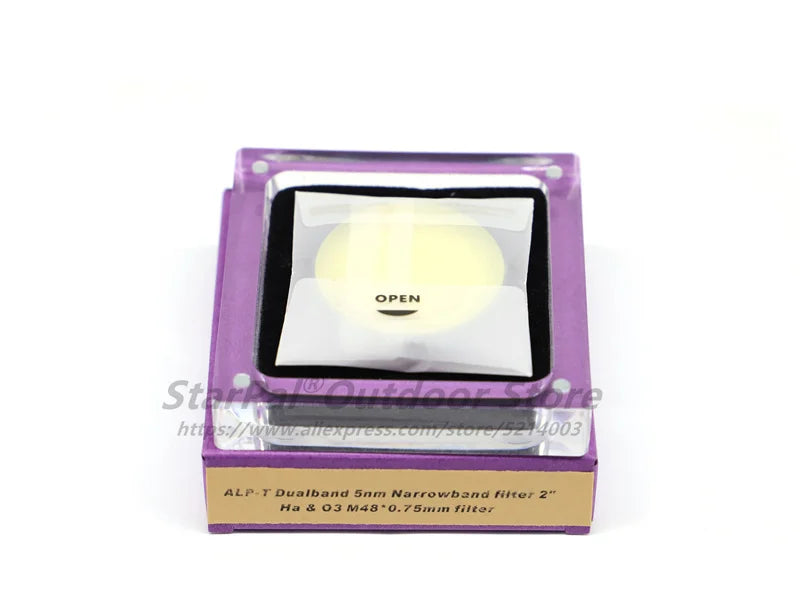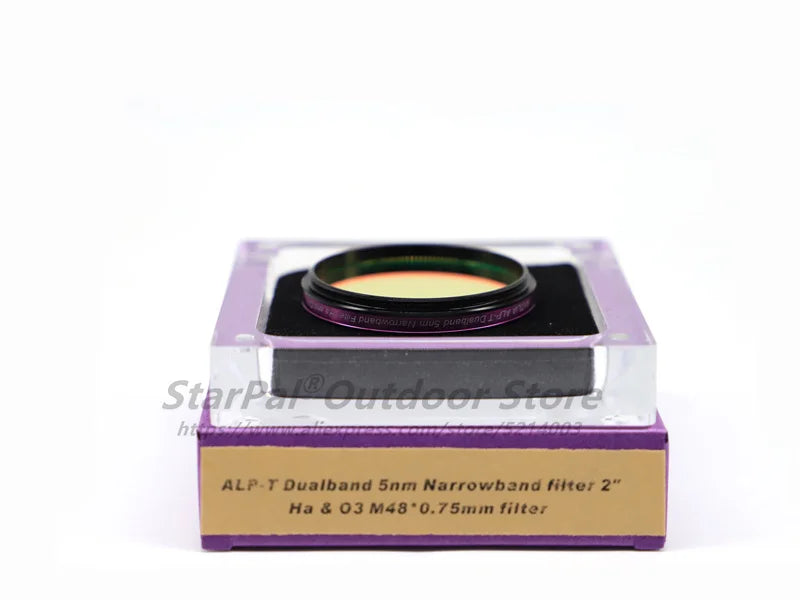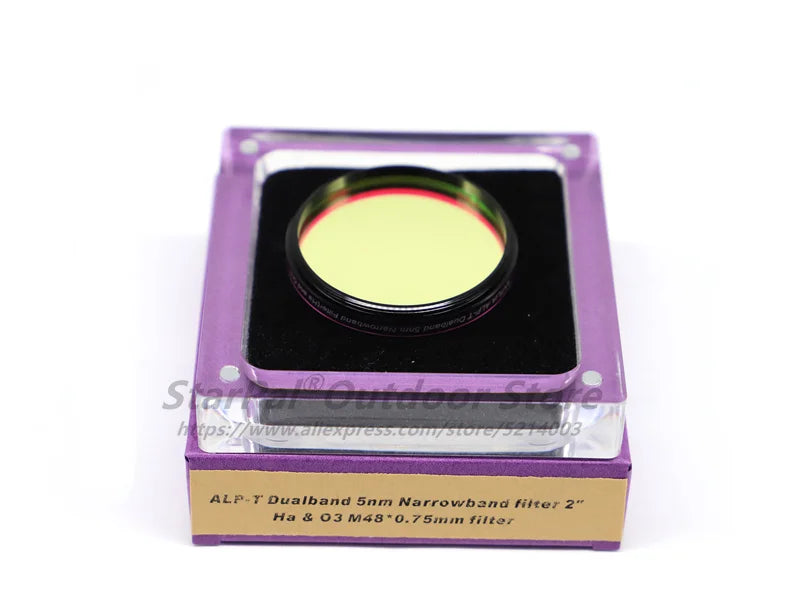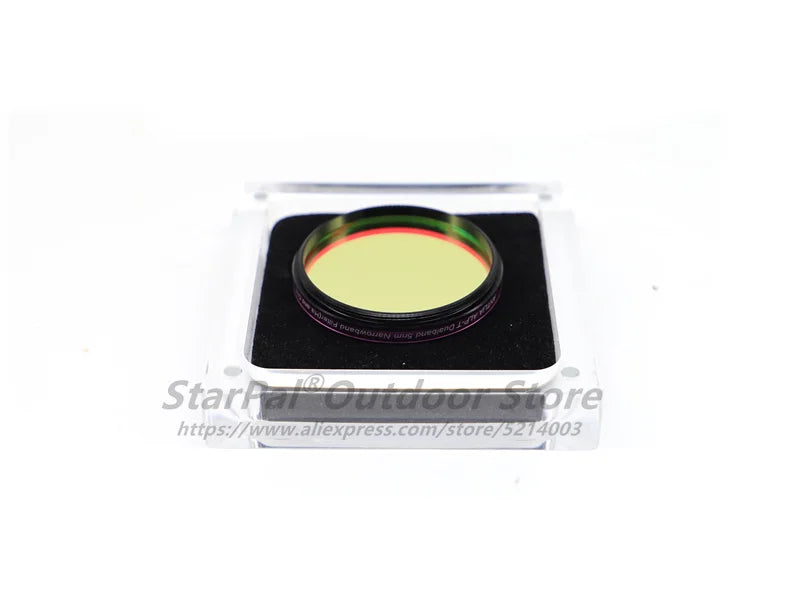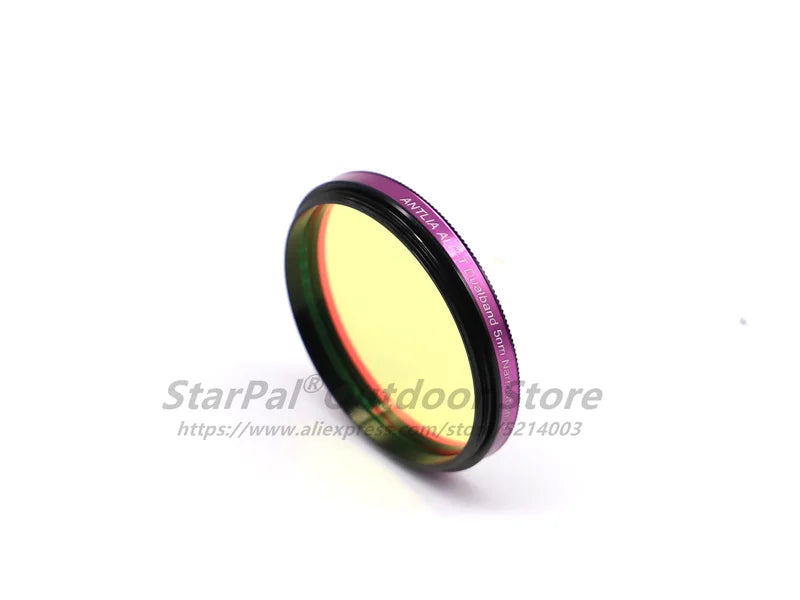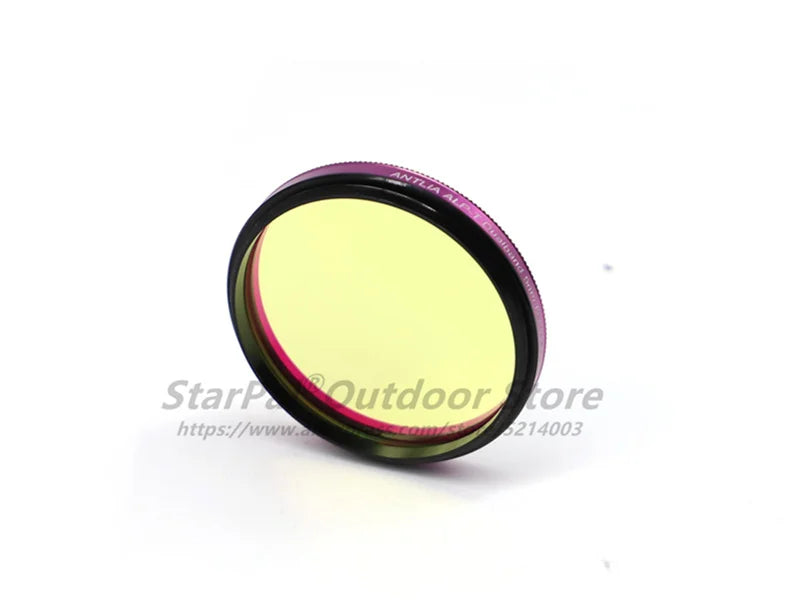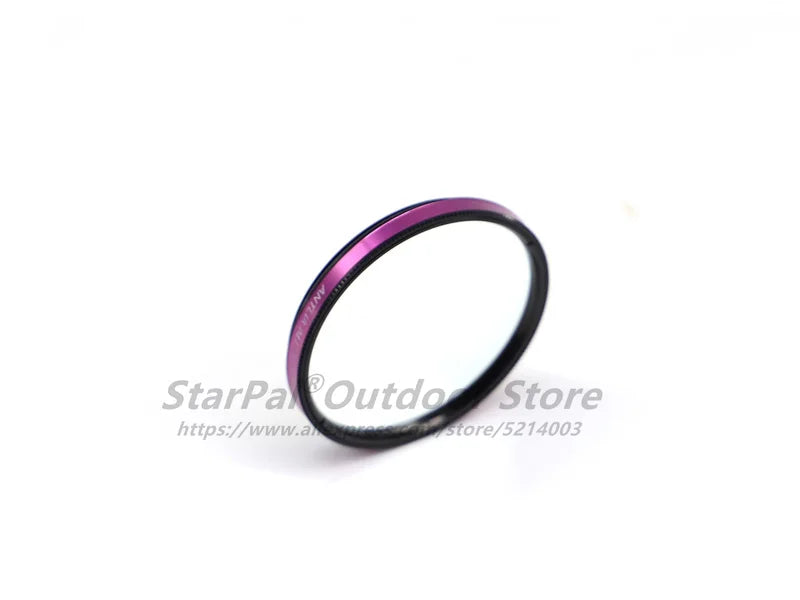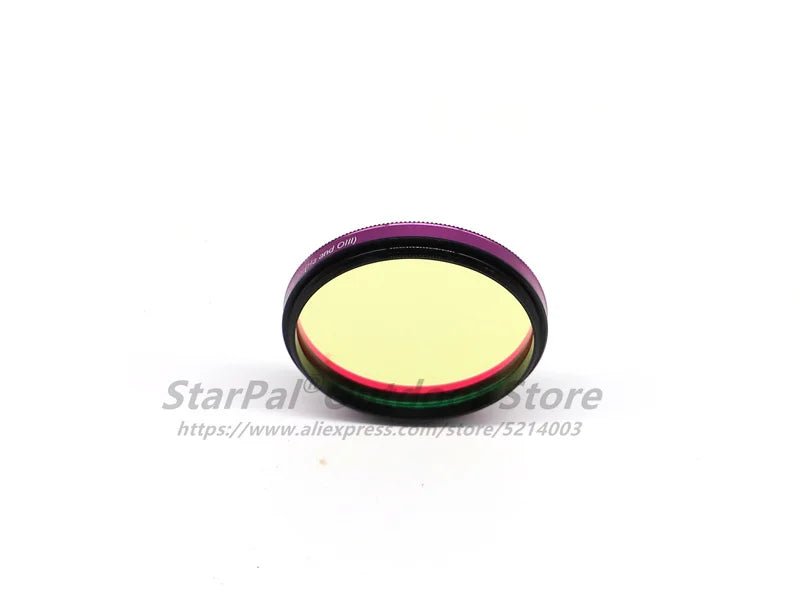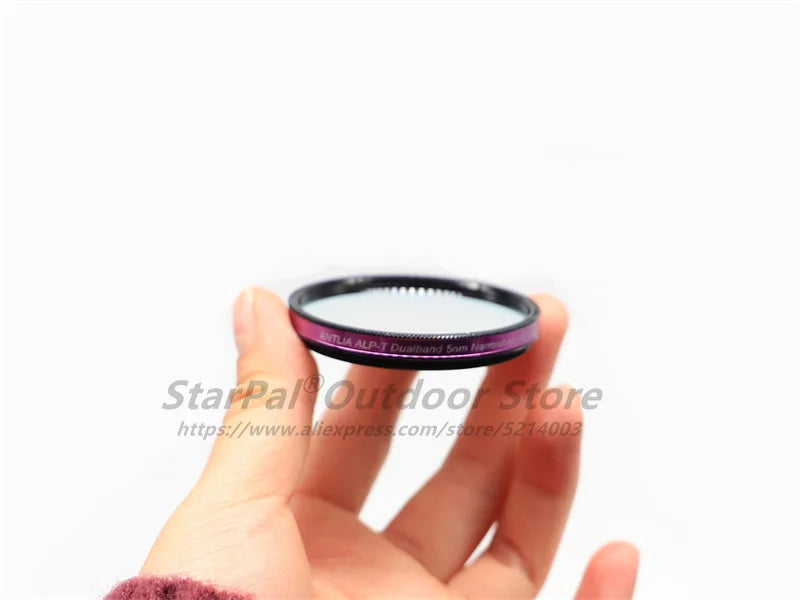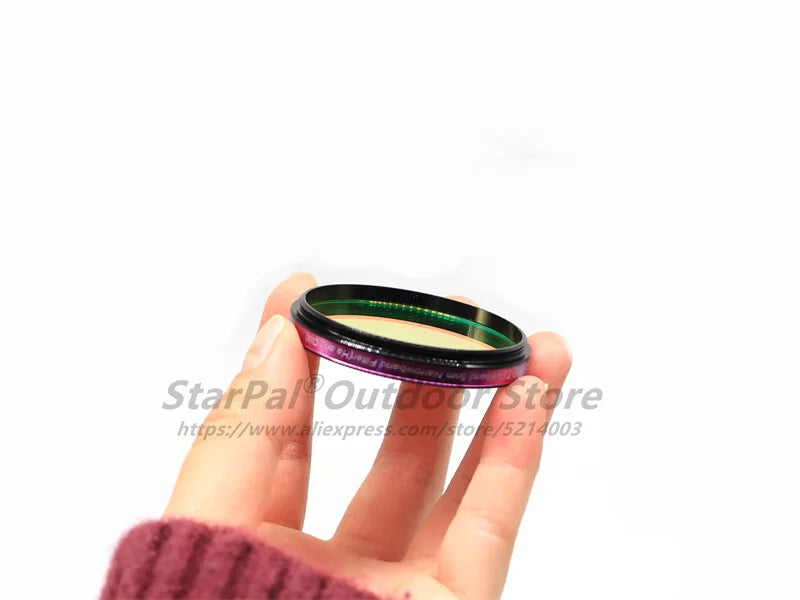Antlia
Antlia ALP-T Dual Band 5nm Narrowband OIII and Ha Filter 2" Mounted
Antlia ALP-T Dual Band 5nm Narrowband OIII and Ha Filter 2" Mounted
FREE SHIPPING
Couldn't load pickup availability
Antlia ALP-T Dual Band 5nm Narrowband Ha & OIII Filter 2"
Unlock the full potential of your astrophotography with the Antlia ALP-T Dual Band 5nm Narrowband OIII and Ha Filter 2" Mounted. Specifically designed to elevate your imaging experience, this filter is a must-have tool for anyone serious about capturing the intricate beauty of the night sky.
Key Features of the Antlia ALP-T Dual Band 5nm Filter
The Antlia ALP-T Dual Band 5nm Filter is a dual line-pass filter crafted to enhance the performance of one-shot color (OSC) cameras such as DSLRs and astronomical OSC cameras. It can also serve as a narrowband filter for monochrome cameras, providing flexibility and efficiency in your imaging sessions.
Advanced Multi-Coatings for Superior Performance
One of the standout features of the Antlia ALP-T Dual Band 5nm Filter is its advanced multi-coatings. These coatings are designed to effectively isolate the red Hydrogen-alpha (Ha) and blue-green Oxygen III (OIII) light from emission nebulae. This isolation results in the suppression of unwanted wavelengths from light pollution, moonlight, and airglow. By eliminating these interferences, the filter significantly enhances the signal-to-noise ratio and contrast in your images, ensuring that you capture the finest details with remarkable clarity.
Dual Bandpass for Enhanced Nebulae Imaging
The filter's dual bandpass capability allows it to capture the two main emission nebulae bands simultaneously while suppressing unwanted light pollution. This dual functionality not only results in cleaner data but also reduces the need for extensive post-processing, making it easier to isolate faint details from the background.
Golden Filter Aesthetic
The Antlia ALP-T Dual Band 5nm Filter is visually distinct with its golden yellow appearance, earning it the nickname "Golden Filter". This aesthetic is not just for show; it reflects the filter's exceptional performance in isolating specific wavelengths of light, ensuring that your images are both vibrant and detailed.
Application and Performance
The Antlia ALP-T Dual Band 5nm Filter is engineered for a variety of applications, making it a versatile addition to your astrophotography toolkit.
Compatibility with DSLR, CMOS, and CCD Cameras
Whether you're using a DSLR, CMOS, or CCD color camera, this filter is designed to enhance your imaging capabilities. Its advanced technology ensures that it performs well across different camera types, providing consistent and high-quality results.
Suppression of Unwanted Visual Wavelengths
The filter's suppression of optical density (OD) 4.5 on unwanted visual wavelengths is a key feature. This suppression enhances the signal-to-noise ratio, ensuring that only the desired wavelengths of light are captured. This results in clearer, more detailed images with minimal interference from light pollution.
Steep Bandpass Edges and Minimal Internal Reflections
The Antlia ALP-T Dual Band 5nm Filter features extremely steep bandpass edges, which minimize internal reflections. This design aspect is crucial for achieving sharp, high-contrast images without the blurring effects caused by reflections.
Ideal Flat-Top and Moderate Bandpass
The filter's ideal flat-top and moderate bandpass design reduce spectrum downshifts, ensuring that your images remain true to their natural colors. This feature is particularly important for capturing the intricate details of nebulae and other celestial objects.
Ion Gun Assisted Deposition Coating Technology
Utilizing Ion Gun Assisted Deposition coating technology on a double-sided polished substrate, the Antlia ALP-T Dual Band 5nm Filter is one of the most consistent and accurate light pollution suppression filters available. This advanced technology ensures that the filter maintains its performance over time, providing reliable results for years to come.
Performance at Various Focal Ratios
The filter performs exceptionally well at focal ratios faster than F3.0, with contrast increasing as the focal ratio increases. This makes it an ideal choice for a wide range of telescopes and imaging setups.
Suppression of Artificial Lighting
Designed to suppress artificial lighting from Bortle scale 1 to Bortle scale 8, the Antlia ALP-T Dual Band 5nm Filter is perfect for use in both urban and rural settings. This versatility ensures that you can capture stunning images regardless of your location.
Near IR Blocking
The filter effectively blocks near-infrared (NIR) light up to 1100nm, preventing unwanted IR light from interfering with your images. This feature further enhances the clarity and detail of your astrophotography.
Technical Specifications
To understand the full capabilities of the Antlia ALP-T Dual Band 5nm Filter, let's explore its technical specifications.
Hydrogen-alpha (Ha) Specifications
- FWHM: 5nm
- CWL (Central Wavelength): 656.3nm
- Peak Transmission: 90%
- Blocking: ≥OD4.5 @ 300-1100nm
- Filter Thickness: 2mm +/- 0.05mm
Oxygen III (OIII) Specifications
- FWHM: 5nm
- CWL (Central Wavelength): 500.7nm
- Peak Transmission: 82%
- Blocking: ≥OD4.5 @ 300-1100nm
- Filter Thickness: 2mm +/- 0.05mm
Filter Ring
- Size: 2’’ Mounted (M48*0.75 thread)
- Ultra-Thin Filter Cell: Designed to minimize vignetting by maximizing possible clear aperture
- Finish: Black Anodized Finish
- Laser Engraving: Ensures no fading over time
Benefits of the Antlia ALP-T Dual Band 5nm Narrowband OIII and Ha Filter 2" Mounted
The Antlia ALP-T Dual Band 5nm Narrowband OIII and Ha Filter 2" Mounted offers a range of benefits that make it an invaluable tool for astrophotographers:
- Superior Signal-to-Noise Ratio: The advanced multi-coatings effectively isolate the desired wavelengths, enhancing the signal-to-noise ratio and providing clearer, more detailed images.
- Dual Bandpass Capability: Captures the Hydrogen-alpha (Ha) and Oxygen III (OIII) emission lines simultaneously, allowing for detailed imaging of nebulae and other deep-sky objects.
- Light Pollution Suppression: Minimizes the impact of light pollution, moonlight, and airglow, making it ideal for urban astrophotography.
- Versatility: Compatible with DSLR, CMOS, and CCD color cameras, and also usable with monochrome cameras.
- Durable Design: Features an ultra-thin filter cell, black anodized finish, and laser engraving for long-lasting performance.
- Consistent Performance: Ion Gun Assisted Deposition coating technology ensures consistent and accurate light pollution suppression over time.
What is the Antlia ALP-T Dual Band 5nm Filter Used For?
The Antlia ALP-T Dual Band 5nm Filter is used primarily for astrophotography, specifically for capturing detailed images of emission nebulae and other deep-sky objects. It isolates the Ha and OIII emission lines, which are crucial for revealing the intricate structures and details of these celestial bodies. The filter's ability to suppress light pollution also makes it an excellent choice for urban astrophotography.
Usage of the Antlia ALP-T Dual Band 5nm Filter
Setting Up the Filter
- Attach the Filter: Screw the 2" mounted filter onto your camera or telescope. Ensure it is securely fastened to avoid any movement during imaging.
- Camera Settings: Adjust your camera settings based on your specific setup and the object you are imaging. Longer exposure times may be required to capture faint details.
- Focus: Carefully focus your camera to ensure sharp images. The filter's design minimizes internal reflections, helping you achieve crisp, clear images.
Imaging Tips
- Location: While the filter is effective in suppressing light pollution, choosing a location with minimal artificial light will yield the best results.
- Exposure Times: Experiment with different exposure times to find the optimal settings for your specific imaging conditions.
- Stacking Images: Consider stacking multiple images to enhance detail and reduce noise. Software like DeepSkyStacker can be useful for this process.
- Post-Processing: Utilize post-processing software to further enhance your images. Adjusting contrast, brightness, and color balance can bring out the finest details.
Tips for Using the Antlia ALP-T Dual Band 5nm Filter
- Calibrate Your Camera: Regularly calibrate your camera to ensure accurate color representation and optimal performance.
- Use a Sturdy Tripod: To avoid camera shake and blurry images, use a sturdy tripod or mount.
- Monitor Weather Conditions: Clear skies are essential for astrophotography. Check weather forecasts to plan your imaging sessions.
- Avoid Dew Formation: Use a dew heater or shield to prevent dew from forming on the filter, which can obscure your images.
- Experiment with Different Objects: Use the filter to capture a variety of deep-sky objects, not just nebulae. It can be effective for galaxies and star clusters as well.
Frequently Asked Questions (FAQ)
Q1: Can I use the Antlia ALP-T Dual Band 5nm Filter with my DSLR camera?
A1: Yes, the filter is compatible with DSLR cameras as well as CMOS and CCD color cameras.
Q2: Is the filter suitable for solar imaging?
A2: No, the filter is not recommended for solar imaging. It is designed for deep-sky astrophotography.
Q3: How do I clean the filter?
A3: Use a soft, lint-free cloth or a specialized lens cleaning tissue to gently clean the filter. Avoid using harsh chemicals that could damage the coatings.
Q4: Can I use the filter for visual observations?
A4: The filter is not intended for night visual observation. It is optimized for astrophotography.
Q5: What is the significance of the 5nm bandpass?
A5: The 5nm bandpass isolates specific wavelengths (Ha and OIII), allowing for detailed imaging of emission nebulae while suppressing unwanted light.
Why Should You Buy the Antlia ALP-T Dual Band 5nm Filter?
- Enhanced Imaging: The filter significantly improves the quality of your astrophotography by isolating specific wavelengths and suppressing light pollution.
- Versatility: Suitable for various camera types and imaging setups, offering flexibility for different astrophotography needs.
- Durability: Designed to withstand the rigors of regular use, ensuring long-term reliability and performance.
- Ease of Use: Simple to attach and use, making it accessible for both novice and experienced astrophotographers.
- Quality Assurance: Each filter is individually tested to meet high performance standards, providing peace of mind regarding its quality.
Popular Targets with the Antlia ALP-T Dual Band 5nm Filter
The filter is ideal for capturing a range of deep-sky objects. Some popular targets include:
- Orion Nebula (M42): Capture the stunning details of this bright emission nebula.
- Horsehead Nebula (Barnard 33): Reveal the intricate structure of this dark nebula against the backdrop of the bright emission nebula IC 434.
- Eagle Nebula (M16): Highlight the famous "Pillars of Creation" within this star-forming region.
- Lagoon Nebula (M8): Showcase the vibrant colors and details of this large emission nebula.
- Veil Nebula: Capture the delicate filamentary structures of this supernova remnant.
Application Scenarios
The Antlia ALP-T Dual Band 5nm Filter is versatile and can be used in a variety of scenarios to achieve exceptional results in astrophotography.
Deep-Sky Imaging
For deep-sky imaging enthusiasts, this filter is an invaluable tool. Its ability to isolate the Hydrogen-alpha and Oxygen III emission lines allows for detailed and high-contrast images of nebulae, revealing structures and features that would otherwise be obscured by light pollution and atmospheric conditions.
Urban Astrophotography
Astrophotographers in urban environments often struggle with light pollution. The Antlia ALP-T Dual Band 5nm Filter addresses this issue by effectively suppressing unwanted wavelengths, allowing you to capture stunning images even in areas with significant artificial lighting.
Monochrome Camera Usage
While designed primarily for one-shot color cameras, the filter can also be used with monochrome cameras to save imaging time. This versatility makes it a practical choice for photographers looking to maximize their imaging efficiency.
Important Usage Notes
While the Antlia ALP-T Dual Band 5nm Filter offers exceptional performance, it's important to note some key usage considerations.
Not Recommended for Solar Imaging
The filter is not recommended for solar imaging. Its design and specifications are optimized for capturing deep-sky objects, and using it for solar observations could result in suboptimal performance and potential damage.
Avoid Night Visual Observation
Similarly, the filter is not intended for night visual observation. Its specialized design for astrophotography means that it may not provide the desired results for visual observations.
Safety Warning
DO NOT LOOK AT THE SUN WITH ANTLIA FILTERS. Serious eye damage will result if you fail to observe this warning. Always follow safety guidelines and use appropriate solar filters for solar observations.
Why Choose the Antlia ALP-T Dual Band 5nm Filter?
When selecting a filter for astrophotography, it's important to consider factors such as performance, versatility, and reliability. The Antlia ALP-T Dual Band 5nm Filter excels in all these areas, making it a top choice for astrophotographers of all skill levels.
Superior Signal-to-Noise Ratio
The advanced multi-coatings and precise design of the Antlia ALP-T Dual Band 5nm Filter result in a superior signal-to-noise ratio. This means that your images will be clearer and more detailed, with less interference from unwanted wavelengths.
Versatile Application
Whether you're using a DSLR, CMOS, or CCD camera, the filter's compatibility ensures that you can achieve excellent results across different imaging setups. Its performance at various focal ratios also adds to its versatility.
Durable and Reliable
The filter's Ion Gun Assisted Deposition coating technology and double-sided polished substrate ensure that it remains consistent and accurate over time. The black anodized finish and laser engraving further enhance its durability, making it a reliable tool for long-term use.
Excellent Performance in Urban Environments
The filter's ability to suppress artificial lighting makes it an ideal choice for urban astrophotographers. Whether you're capturing images from a city or a rural area, the Antlia ALP-T Dual Band 5nm Filter ensures that you can achieve stunning results regardless of your location.
Conclusion
The Antlia ALP-T Dual Band 5nm Narrowband OIII and Ha Filter 2" Mounted is a powerful and versatile tool designed to enhance your astrophotography experience. With its advanced multi-coatings, dual bandpass capability, and exceptional performance in various environments, this filter is a must-have for anyone serious about capturing the beauty of the night sky.
Whether you're an experienced astrophotographer or just starting out, the Antlia ALP-T Dual Band 5nm Filter offers the performance, reliability, and versatility you need to take your imaging to the next level. Invest in this premium filter and see the difference it can make in your astrophotography.
Share
